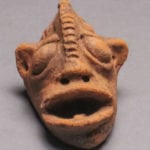 Weird Stuff
Weird Stuff  Weird Stuff
Weird Stuff  Mysteries
Mysteries 10 Tragic Disappearances and Deaths in Joshua Tree National Park
 History
History 10 Ways Childhood Really Sucked in the Old West
 Music
Music 10 Name Origins of Famous Bands from the 1990s
 Religion
Religion 10 Biggest Turnarounds by the Catholic Church
 Weird Stuff
Weird Stuff 10 Unbelievable Times Laws Had Unintended Consequences
 Humans
Humans Ten Historic Women Who Deserve Way More Credit Than They Got
 Movies and TV
Movies and TV 10 Films That Spawned Major Lawsuits
 History
History Ten Times Towns Were Wiped Off the Face of the Earth
 Creepy
Creepy 10 of the Most Disturbingly Haunted Public Houses in the UK
 Weird Stuff
Weird Stuff 10 Niche Subcultures That Are More Popular Than You Might Think
 Mysteries
Mysteries 10 Tragic Disappearances and Deaths in Joshua Tree National Park
 History
History 10 Ways Childhood Really Sucked in the Old West
Who's Behind Listverse?

Jamie Frater
Head Editor
Jamie founded Listverse due to an insatiable desire to share fascinating, obscure, and bizarre facts. He has been a guest speaker on numerous national radio and television stations and is a five time published author.
More About Us Music
Music 10 Name Origins of Famous Bands from the 1990s
 Religion
Religion 10 Biggest Turnarounds by the Catholic Church
 Weird Stuff
Weird Stuff 10 Unbelievable Times Laws Had Unintended Consequences
 Humans
Humans Ten Historic Women Who Deserve Way More Credit Than They Got
 Movies and TV
Movies and TV 10 Films That Spawned Major Lawsuits
 History
History Ten Times Towns Were Wiped Off the Face of the Earth
 Creepy
Creepy 10 of the Most Disturbingly Haunted Public Houses in the UK
10 Unique Tattoo Pieces And Tattooing Traditions
Why do people get tattoos?
Because of traditions and some cultural milestones? For personal fulfillment and a sense of identity? But why are tattoos so fascinating? Is it the tools used to make these markings or the stories that lie beneath the surface of the ink?
This list compiles a diverse group of tattoo pieces, traditions, and stories that are both interesting and answer some of these questions.
10 Olive Oatman And The Mojave Tribe
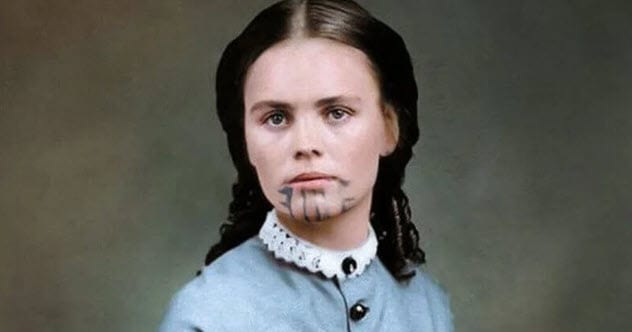
Native Americans have extensive cultural traditions that involve tattooing, but each group has different customs. In the past, several factors affected their tattooing, such as the location of the group, the natural resources to which they had access, and the religion and creation stories in which they believed.
A specific example is the Mojave tribe, which was known at least as far back as the 16th century by the Spanish. Located mainly in California and Arizona along the Colorado River, the tribe used ink from the blue cactus plant to tattoo adolescents as a rite of passage. The Mojave also got tattoos for luck and protection when heading into battle and for religious ceremonies.
Unfortunately, there aren’t many pictures of the Mojave people available today. However, a set of famous pictures of Olive Oatman shows her Mojave chin tattoos. Her story is unorthodox because Oatman wasn’t a Mojave person. She was white.[1]
When Olive was a child, a group of Native Americans, thought to be the Tolkepayas/Western Yavapai, killed her family. Olive and her sister Mary Ann were taken captive by the group as slaves. Only their brother Lorenzo survived the attack as a free person, though he was badly injured.
The girls were frequently mistreated by their captors until they were traded to a Mojave group in California a year later. Tribal leader Espianola and his family adopted the girls. Espianola’s wife, Aespaneo, and daughter Topeka gave the Oatman girls land to farm.
The Mojave gave both girls blue cactus tattoos on their chins, a tradition in their group to ensure a good afterlife. The girls lived with the tribe for several years until Mary Ann tragically died of starvation during a drought that killed several other Mojave people.
Olive left after the US Army bribed and then threatened the Mojave people. Reunited with Lorenzo, Olive would speak often of her time with the Mojave. Although she was positive in the beginning, her opinion of them appeared to sour as time went on. How she truly felt about her time with the Mojave remains a mystery.
9 Dulong Tattoos
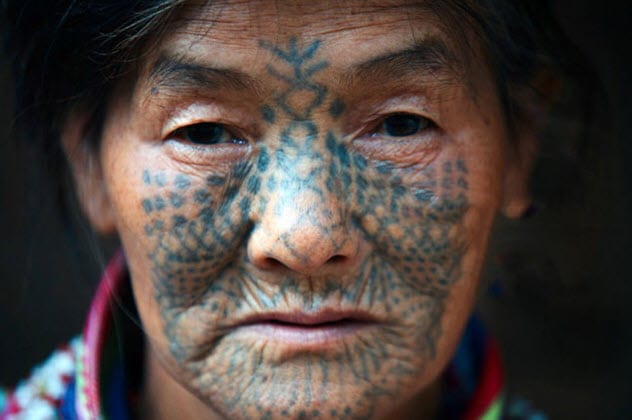
The Dulong people are a minority in China who lived in an inaccessible area in the Yunnan Province until a highway was built in late 1999. It was a tradition for girls to get a face tattoo when they began puberty, a tradition called “Hua Lian” (“painting the face”) or “Wen Mian” (“tattooing the face”).
The tattoos were first drawn with soot and water by an elder and then stabbed into the skin using a needle or sharpened stick. When the drawing was finished, they would rub some soot or grass juice into the wound to turn the resulting scars blue.
In the areas along the upper and middle reaches of the Dulong River, the tattoos were a complex pattern of connecting diamonds down the bridge of the nose and across the cheeks and mouth. In the lower reaches, the designs were much simpler. All tattoos were butterfly shaped as they believed that the dead turned into butterflies when they passed.
The reasons for these tattoos vary, although several sources claim that the tattoos were supposed to make their women less attractive to Lisu and Tibetan slavers. Tibetan landlords demanded that the Dulong women be taken as slaves if their families could not pay their taxes.[2]
In passive defiance, Dulong women carved and dyed their faces black and blue with soot. The girls made sure that their markings couldn’t be washed away in the hopes of making themselves less attractive, even frightening, to foreigners.
The practice became a cultural tradition until the founding of the People’s Republic of China in 1949. Fewer than 30 women with traditional Dulong tattoos are still alive today.
8 R.H. Macy

As a young man of 15 years, Rowland Hussey Macy became a sailor on Emily Morgan, a whaling ship, in the early 19th century. During his four years as a whaler, Macy got a red star tattooed on his forearm. This symbolized the stars that guided him on those cold nights at sea.
When Macy returned home, he opened a string of failed stores and then went to work for his brother-in-law’s shop in Boston. Afterward, Macy did a brief stint searching for gold in the California Gold Rush of 1849.
Once again, Macy experienced bitter failure. But he never truly gave up his dreams of opening a successful shop. So Macy opened another dry goods store in Haverhill with his brother and, for the first time, had some success with the business.
This inspired Macy to finally move to New York in 1858 to open R.H. Macy & Co. The first day only brought in a modest $11.06. By the end of the year, the store earned $85,000. R.H. Macy & Co expanded into 11 buildings and became a department store. Its logo became R.H. Macy’s red star tattoo.[3]
7 William Lithgow
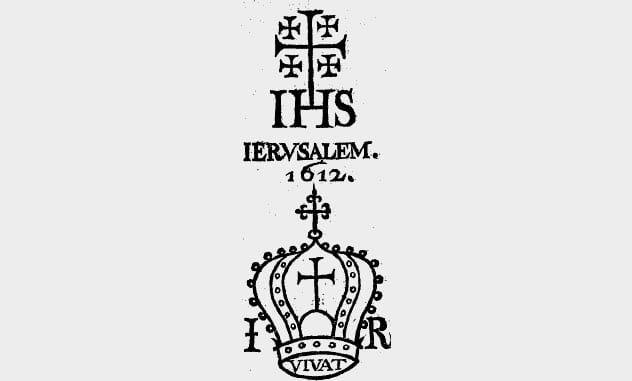
William Lithgow was a Scotsman who traveled the world and documented his adventures in several literary works in the 17th century. During a visit to Jerusalem, he and some companions got their pilgrimage tattoos. Lithgow’s tattoo was a quote professing his pride and loyalty to his homeland’s monarchy. He wrote of the tattoo:
In the last night of my staying at Jerusalem, which was at the holy grave, I remembring that bounden duty, & loving zeale, which I owe unto my native Prince; whom I in all humility (next and immediate to Christ Jesus) acknowledge to be the supreme head, and Governour of the true Christian and Catholicke Church; by the remembrance of this obligation I say, I caused one Elias Bethleete, a Christian inhabitour of Bethleem, to ingrave on the flesh of my right arme, The never-conquered Crowne of Scotland, and the now inconquerable Crowne of England, joyned also to it, with this inscription, painefully carved in letters, within the circle of the Crowne, Vivat Jacobus Rex.
At the time, most pilgrimage tattoos contained solely Christian emblems and quotations. Lithgow got other pilgrimage tattoos, but they were only mentioned in annotations.
In his biographies, he has frequently been referred to as a spy. During one of his adventures in Spain in 1620, he was captured and tortured for giving crucial information to an English ship. Trying to get a confession from Lithgow, Spanish inquisitors cut his tattoo and a sizable amount of flesh from his arm.
His account of the event was this: “The Corrigidor . . . gave direction, to teare a sunder, the name, and Crowne (as hee sayd) of that Hereticke King, and arch-enemy to the Holy Catholicke Church . . . cutting the Crowne, sinewes and flesh to the bare bones.”[4]
Lithgow never fully recovered and narrowly avoided being burned at the stake. Later, he returned to Britain.
6 Otzi The Iceman
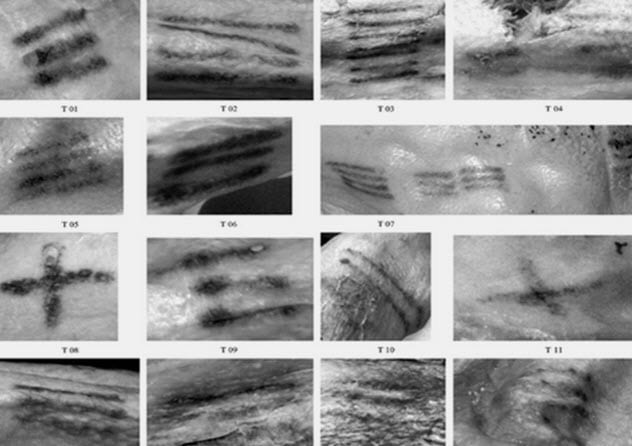
Otzi is a mummy that was naturally preserved in the Otztal Alps over 5,000 years ago. He was found by two German tourists in 1991. Otzi is so well-preserved that anthropologists can still see his tattoos, of which 61 have been identified.
Scientists have speculated on everything from Otzi’s cause of death and illness to his modern relatives and his diet. They also have theories about his tattoos. For example, they were probably done by first pricking the pattern using some kind of needle or stick and then rubbing soot over the skin.
Given how dark Otzi’s skin is, some of his tattoos are difficult to see with the naked eye. Several were discovered using a noninvasive multispectral imaging technique to separate each color wavelength on Otzi’s skin.
Anthropologists have speculated that many of Otzi’s tattoos were an archaic form of acupuncture that was done for therapeutic reasons. Many were located where he had physical damage—such as his Achilles tendon, lower back, wrist, and ankles.
If so, it would mean that acupuncture was developed nearly 2,000 years earlier than previously thought. Even so, researchers said:
Of course, we can’t be absolutely sure why these tattoos were placed in those locations. It’s possible Otzi’s people believed those regions of the body were spiritually significant. Still, it’s very possible that this was an early effort at acupuncture.
For example, the tattoos of Otzi’s chest are not placed over any recognizable ailment or injury. The true purpose of his tattoos are still unclear. But whether they were decorative or therapeutic, they open a window into Otzi’s culture and heritage that we never would have witnessed otherwise.[5]
5 Mai
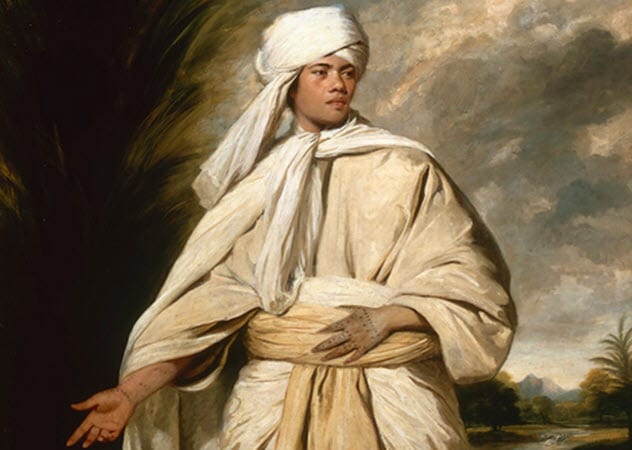
Mai was born on Raiatea, an island in French Polynesia. He fled to Tahiti during an invasion of Raiatea by Borbora warriors in the 1700s. Captain Wallis and his crew on the HMS Dolphin were the first Europeans to “discover” Tahiti around 1767. They tried to claim the island for Britain and crush the resistance of the natives who fought against the invasion.
As time went on, more European ships arrived and the islanders suffered from the restricted food supply and conflict with the colonizers. Some islanders were taken as “specimens” back to England but perished during the journey.
When Captain Cook returned in 1773, Mai (mistakenly called Omai by the British) asked to accompany them back to Europe so that he could obtain guns and other weaponry to fight back against the men of Borabora and reclaim Raiatea.
Mai was paraded around the country by another English man, Sir Joseph Banks. Mai met many high-society members including King George III. Before Mai returned with Captain Cook to Tahiti in 1776, he had his portrait done by the famed painter Sir Joshua Reynolds.
Portrait of Omai has a shoeless Mai clad in white robes with his tattooed hands outstretched to draw the attention of the viewer. Mai’s tattoos were a series of dots over the back of his hands and around his wrists.
His tattoos displayed his foreignness to the European public. At the time, he was the perfect representation of the European ideal of the “noble savage” who was seen as less than human.[6]
4 People Of The Arctic And The Inuit

It was speculated that people of the Arctic took part in a string of similar tattooing traditions after an ivory mask, that may have dated back over 3,500 years, was recovered on Devon Island. The tattoos depicted on the mask are sets of parallel lines from forehead to lips to chin. Similar designs were found in several northern communities around the globe.
The Inuit traditions involving tattooing were first recorded by Sir Martin Frobisher in 1576 when he wrote:
The women are marked on the face with blewe streekes down the cheekes and round about the eies. [ . . . ] Also, some of their women race [scratch or pierce] their faces proportionally, as chinne, cheekes, and forehead, and the wristes of their hands, whereupon they lay a colour, which continueth dark azurine.[7]
Unfortunately, the Inuit people were shamed for their facial tattoos for many decades when their communities were Christianized by missionaries. Shamans were converted to Christianity, and their cultural and religious practices were phased out. Some tattoos were also done for pain relief (like acupuncture), but the medical techniques of the Europeans rendered those practices obsolete.
Luckily, cultural tattoos in the Arctic Inuit communities are being destigmatized, albeit slowly, due to the work of people like Holly Mititquq Nordlum and Maya Sialuk Jacobsen. They are a pair of artists/tattooists who are slowly reintroducing the tattooing techniques of skin stitching and hand poking to their community through their apprenticeship programs.
3 Bert Grimm And The US Criminal Underworld
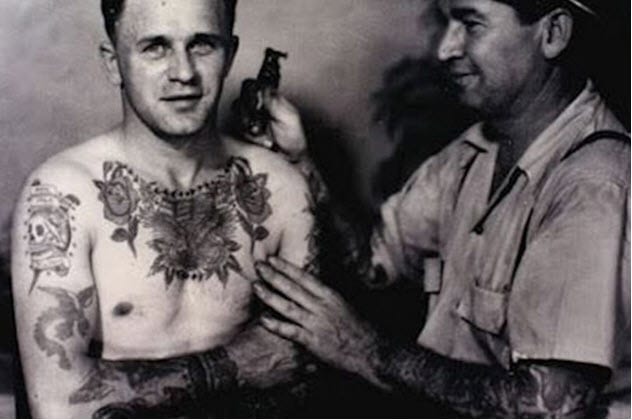
Bert Grimm was a US tattooist. He started his career after running away from home at 15 to become a sideshow tattoo artist. While on the road, Grimm met with other tattooists—such as Shorty Schultz, Percy Waters, and Long Andy Libarry—which helped to develop his technique. Eventually, Grimm operated different tattoo shops in Chicago, Las Vegas, Long Beach, and St. Louis.
Grimm was also an avid storyteller, taking time during a session to sell his brand and talk about his experiences. The eccentricities of his most famous customers are one of the many things that made Grimm so fascinating. He was rumored to have done tattoos for the famed crime couple Bonnie and Clyde, although what the tattoos looked like is unclear.
Reportedly, Grimm also tattooed Charles Arthur (“Pretty Boy”) Floyd, the US bank robber. Floyd had a “Rose of No Man’s Land” tattoo. (A song by the same name was meant to honor Red Cross nurses from World War I.)
Floyd’s tattoo was described in the scars and marks section of one of his wanted posters. Grimm claimed that he had tattooed Floyd at some unknown time at his shop in St. Louis.
Apparently, Grimm had been unaware of this until a US marshal had shown up at his shop. The marshal asked Floyd about the tattoo because he wanted one done on himself. After visiting Grimm, the marshal left with the same tattoo.
Grimm’s gift of gab helped spread his reputation as “the greatest tattoo artist in the world.” His career continued for approximately 70 years until his death in 1985.[8]
2 Irezumi
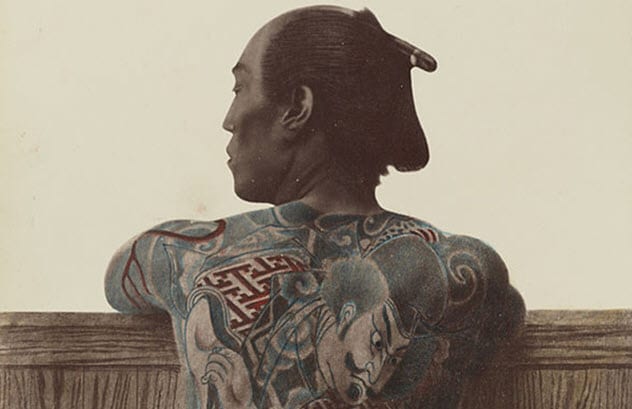
Irezumi (“inserting ink”) is the Japanese term for tattooing, which originated in the Jomon period. Evidence of facial tattoos that were associated with established social ranks or evading evil spirits has been found from several clay figurines in tombs. The full body tattoo (horimono) is a beautiful and intricate tradition that showed off wealth, especially when tattoos were still illegal in Japan.
Tattoos became controversial in Japan mostly due to an association with criminal activity such as the Yakuza, a crime syndicate that is feared in the country. The Yakuza believe that tattoos are a sign of courage because of the pain to have them done.[9]
Also, this negative view of tattoos may have occurred due to the rising Chinese influence in Japanese culture during the 17th century. Prisoners were given facial tattoos in China as a permanent branding to mark their criminality if the offense was severe enough. After the branding, criminals could be exiled as well.
This practice was adopted by the Japanese. Each region had a design for different crimes so that people could tell where the crime had been committed. Tattoos have been legal in Japan for decades, but the negative connotations are still present in some areas.
1 Tattooed Ladies And Circus Freaks
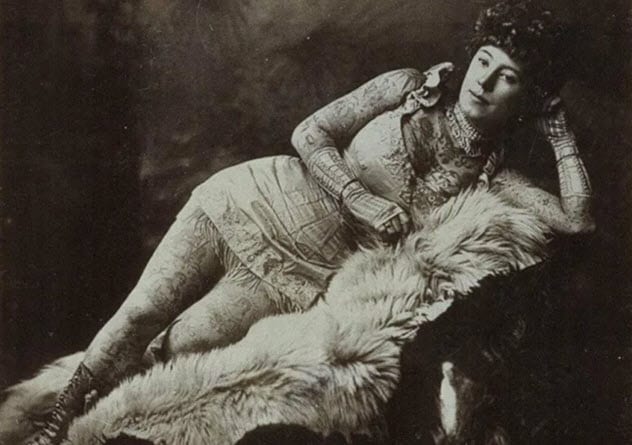
The public has been fascinated by the strange and unusual for centuries, so it stands to reason that someone would capitalize on that fascination at some point. “Freak shows” peaked in popularity in the late 1800s and early 1900s.
These shows spotlighted people with peculiar physical and mental conditions, such as Schlitzie (“The Last of the Aztecs”), Frank Lentini (“The Three-Legged Man”), and Joseph Merrick (“The Elephant Man”). But not every person was born with their peculiarity. Tattooed people, particularly women, enthralled audiences with fantastic and often false tales of how they got their tattoos.
George Contentenus (“The Tattooed Man”) had over 300 tattoos and claimed to be a prince raised in a Turkish harem. He said that his tattoos had come from “savage natives” of Burma who had threatened to cut him into pieces unless he covered his body in their markings.
Initially, he was so insistent about the truth of this story that he even published a book about the tale. Years later, he admitted that it was a false narrative designed to make him rich and famous.
Many tattooed ladies told fictitious stories about Native Americans giving them their tattoos. But not all their fame came from the stories they told.
Artoria Gibbons was the highest-paid tattooed lady of her time and had all her markings done by her partner, “Red” Gibbons. Artoria had an impressive following, most of whom were male, and continued performing as a tattooed lady into her eighties.[10]
Although freak shows have died out, the fascination they had with tattoos lives on. The exhibition of tattoos in these shows helped to glorify and normalize tattooing in Western culture.
Savannah O. Skinner is a freelance writer and author from Canada, sometimes working under the pen name S.O. Skinner.
Read more tantalizing tales about tattoos on 10 Tantalizing Tales Of Tattoos Throughout History and 10 Mysterious Ancient Tattoos.







